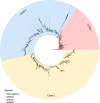16S rRNA phylogeny and clustering is not a reliable proxy for genome-based taxonomy in Streptomyces
- PMID: 39254673
- PMCID: PMC11385388
- DOI: 10.1099/mgen.0.001287
16S rRNA phylogeny and clustering is not a reliable proxy for genome-based taxonomy in Streptomyces
Abstract
Streptomyces is among the most extensively studied genera of bacteria but its complex taxonomy remains contested and is suspected to contain significant species-level misclassification. Resolving the classification of Streptomyces would benefit many areas of applied microbiology that rely on an accurate ground truth for grouping of related organisms, including comparative genomics-based searches for novel antimicrobials. We survey taxonomic conflicts between 16S rRNA and whole genome-based Streptomyces classifications using 2276 publicly available Streptomyces genome assemblies and 48 981 publicly available full-length 16S rRNA Streptomyces sequences from silva, Greengenes, Ribosomal Database Project (RDP), and NCBI (National Centre for Biotechnology Information) databases. We construct a full-length 16S gene tree for 14 239 distinct Streptomyces sequences that resolves three major lineages of Streptomyces, but whose topology is not consistent with existing taxonomic assignments. We use these sequence data to delineate 16S and whole genome landscapes for Streptomyces, demonstrating that 16S and whole-genome classifications are frequently in disagreement, and that 16S zero-radius Operational Taxonomic Units (zOTUs) are often inconsistent with Average Nucleotide Identity (ANI)-based taxonomy. Our results strongly imply that 16S rRNA sequence data does not map to taxonomy sufficiently well to delineate Streptomyces species routinely. We propose that alternative marker sequences should be adopted by the community for classification and metabarcoding. Insofar as Streptomyces taxonomy has been determined or supported by 16S sequence data and may in parts be in error, we also propose that reclassification of the genus by alternative approaches may benefit the Streptomyces community.
Keywords: 16S; evolution; phylogeny; taxonomy; Actinomycetales; Streptomyces.
Conflict of interest statement
The authors declare that there are no conflicts of interest.
Figures







Similar articles
-
GSR-DB: a manually curated and optimized taxonomical database for 16S rRNA amplicon analysis.mSystems. 2024 Feb 20;9(2):e0095023. doi: 10.1128/msystems.00950-23. Epub 2024 Jan 8. mSystems. 2024. PMID: 38189256 Free PMC article.
-
TaxAss: Leveraging a Custom Freshwater Database Achieves Fine-Scale Taxonomic Resolution.mSphere. 2018 Sep 5;3(5):e00327-18. doi: 10.1128/mSphere.00327-18. mSphere. 2018. PMID: 30185512 Free PMC article.
-
Whole genome-based comparative analysis of the genus Streptomyces reveals many misclassifications.Appl Microbiol Biotechnol. 2024 Aug 30;108(1):453. doi: 10.1007/s00253-024-13290-4. Appl Microbiol Biotechnol. 2024. PMID: 39212721 Free PMC article.
-
Proposal of Carbonactinosporaceae fam. nov. within the class Actinomycetia. Reclassification of Streptomyces thermoautotrophicus as Carbonactinospora thermoautotrophica gen. nov., comb. nov.Syst Appl Microbiol. 2021 Jul;44(4):126223. doi: 10.1016/j.syapm.2021.126223. Epub 2021 Jun 10. Syst Appl Microbiol. 2021. PMID: 34157595 Review.
-
A polyphasic strategy incorporating genomic data for the taxonomic description of novel bacterial species.Int J Syst Evol Microbiol. 2014 Feb;64(Pt 2):384-391. doi: 10.1099/ijs.0.057091-0. Int J Syst Evol Microbiol. 2014. PMID: 24505076 Review.
Cited by
-
'What's in a name? Fit-for-purpose bacterial nomenclature': meeting report.Int J Syst Evol Microbiol. 2025 Jul;75(7):006844. doi: 10.1099/ijsem.0.006844. Int J Syst Evol Microbiol. 2025. PMID: 40694390 Free PMC article. Review.
-
Potential pitfalls in claiming novel taxa.Imeta. 2025 Apr 19;4(3):e70036. doi: 10.1002/imt2.70036. eCollection 2025 Jun. Imeta. 2025. PMID: 40469514 Free PMC article.
-
Isolation, Genomic Taxonomy, and Genome Characterization of Streptomyces fradiae SS162, Which has Antibacterial Activity Against Vibrio parahaemolyticus.Curr Microbiol. 2025 Aug 6;82(9):441. doi: 10.1007/s00284-025-04426-4. Curr Microbiol. 2025. PMID: 40768039
References
MeSH terms
Substances
LinkOut - more resources
Full Text Sources
Research Materials

